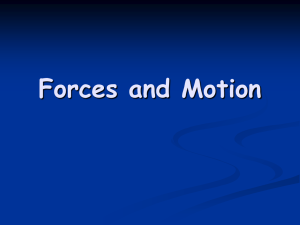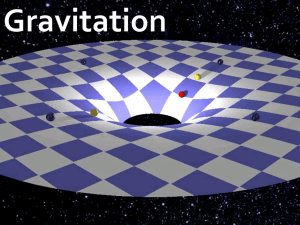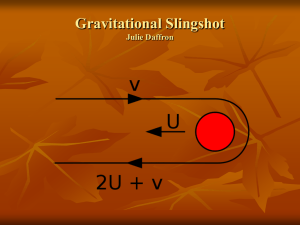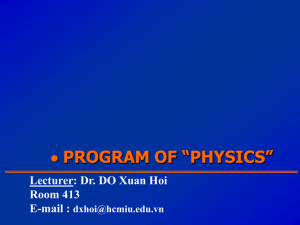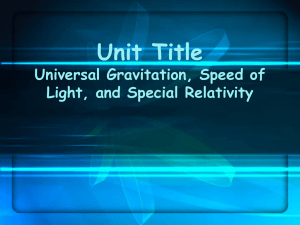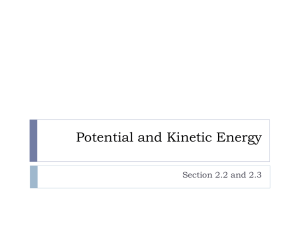Chapter 17: Fields and Forces
advertisement
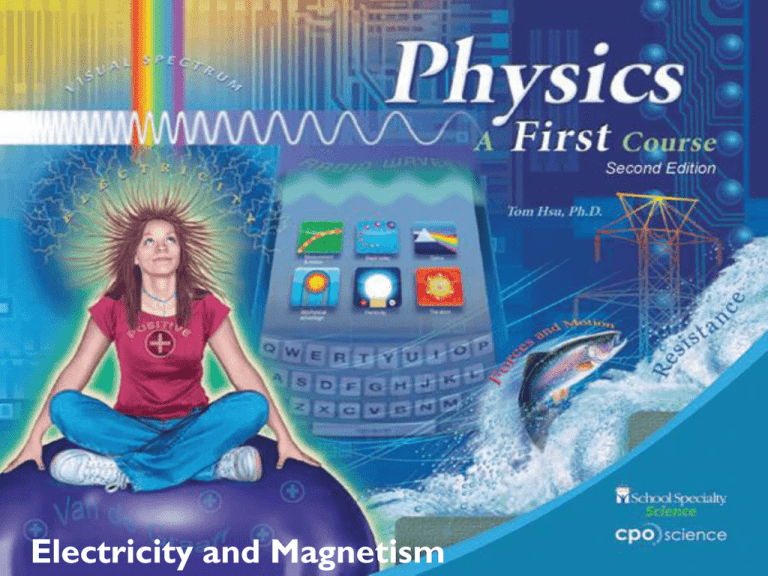
Electricity and Magnetism Unit 5: Electricity and Magnetism Chapter 17: Fields and Forces 17.1 Fields and Forces 17.2 Gravity 17.3 The Electric Field 17.1 Investigation: The Magnetic Field Key Question: Does magnetic force spread out in the area around a permanent magnet? Objectives: Use a compass to map a magnetic field. Map out gravitational and electric fields. Compare and contrast magnetic, gravitational, and electric fields. What is a field? In physics, a field is a physical phenomena that has a value everywhere in space. Loudness has a value everywhere around a stereo. This means you can describe the loudness with a field. All interactions between matter and energy occur by way of fields. Fields and energy Any field is a form of energy that is distributed through space. A magnetic field has energy because it can exert force over distance, or do work, on another magnet. Adding fields Fields of the same kind can be added or subtracted. The field from an electromagnet can either cancel the field from a permanent magnet or add to it. The inverse square law The inverse square law states that a field decreases as the square of the distance from the source of the field increases. While sound, light, gravity and electricity follow this trend, magnetism does not. Intensity All the sound energy you hear must pass through 1 cm2 at the opening to the ear. The intensity—the number of watts per unit area—reaching your ear is 0.01 watts per square centimeter. — Close to the stereo, 0.01 watt of power is captured by the small opening of your ear. — Because the power spreads out, far away from the stereo the intensity drops so that the same square centimeter of your ear captures less than 0.01 watt of power Light intensity and distance At a radius of 1 meter, 8 watts of light fall on a 1meter-square area, so the light intensity is 8 W/m2. The intensity at 2 meters is one-fourth the intensity at 1 meter or 2 W/m2. The inverse square law Magnetism is an exception to the inverse square law because all magnets have two opposite poles, not just one. The magnetic field decreases much faster than an inverse of the square of distance. The north and south poles cancel each other out as you move farther from the magnet. The speed of a field The magnetic field exerts a force of one magnet on another at the speed of light. The speed of light is 300 million m/s, so it takes only a tiny fraction of a second for the force to be exerted by one magnet on another when the distance is a few meters. The speed of light All interactions are carried by fields, and the fastest that any field can spread is the speed of light. Information like your cell phone number and the number you are calling is coded in pulses of energy. The information spreads as an electromagnetic field that expands at the speed of light. Unit 5: Electricity and Magnetism Chapter 17: Fields and Forces 17.1 Fields and Forces 17.2 Gravity 17.3 The Electric Field 17.2 Investigation: Using Fields Key Question: What does a field tell you about what created it? Objectives: Use a compass to map the magnetic field of a hidden magnet and to find its location and orientation. Gravity The All gravitational field is created by mass. mass creates a gravitational field. Gravity is a relatively weak force, so it takes a planetsized mass to create a field strong enough to exert a significant force. Gravitational field of Earth The gravitational field is a force field because it creates a force on masses at all points in space. The force (Fw) on an imaginary mass (m) is equal to the mass multiplied by the gravitational field (g) Earth and Moon Gravitational force acts in two steps. 1. Earth creates a gravitational field. 2. The Moon feels a force from the gravitational field that causes it to orbit Earth. Gravitational fields The gravitational field is a vector field because a gravitational force has a direction at all points in space. Like the magnetic field, you can draw field lines to show the direction of the gravitational field. Law of gravitation The formula for Newton’s law of gravitation can be rearranged. The strength of the gravitational field (g) is given by the quantity Gm2/r2. If we know the mass and radius of a planet, we can use this quantity to calculate the strength of gravity on that planet. Calculating gravitational force The planet Mars has a mass of 6.4 × 1023 kg and a radius of 3.4 million m. Calculate the value of g on the surface of Mars. 1. Looking for: …the value of g in N/kg for Mars 2. Given: …the mass (6.4 x1023 kg) and radius 3.4 x106 m) of Mars 3. Relationships: Use g = Gm2 ÷ r2 and G= 6.67 x10-11 N•m2/kg2 Solution: g = (6.67 ×10−11 N•m2/kg2)(6.4 ×1023 kg) 3.4 ×106 m = 3.7 N/kg on Mars compared to 9.8 N/kg on Earth 4. Unit 5: Electricity and Magnetism Chapter 17: Fields and Forces 17.1 Fields and Forces 17.2 Gravity 17.3 The Electric Field 17.3 Investigation: Electric Fields and Forces Key Question: What are electric fields? Objectives: Use a computer simulation to draw electric fields and infer that electric fields point toward negative charges and away from positive charges. Explain how the presence of multiple charges in a region affect electric field diagrams. Apply Coulomb’s law to calculate the force between charged particles. The Electric field Like gravity, the force between electric charges is carried by a field, called the electric field. By convention, we draw the electric field to represent the force on an imaginary positive test charge. Drawing the electric field Electric field lines follow the direction of the force on a positive test charge. The strength of the electric field is shown by the spacing of the field lines. The field is strong where the field lines are close together and weak where the lines are far apart. Coulomb’s law and electric field The object that creates the field is called the source charge (q1). The charge you place to test the force is the test charge (q2). As with gravity, we can rewrite Coulomb’s law so that the electric field is a separate quantity in the formula. Units of the electric field 1 newton per coulomb is the same as 1 volt per meter. A voltage difference of 1 volt over a space of 1 meter makes an electric field of 1 V/m. The force on a charge in an electric field The force from the electric field accelerates the charge on which it is acting. An electron only accelerates for a short distance before it collides with a copper atom. This is why the constant force from the electric field results in a constant drift velocity for electrons. Calculating electric field on a raindrop A raindrop has a static charge of 0.0001 C. In a thunderstorm, the raindrop experiences an electric field of 1,000 V/m. What would be the force on the drop? 1. Looking for: …force in newtons on the drop 2. Given: …charge (0.0001 C) and electric field (1,000 V/m) 3. Relationships: Use F = qE 4. Solution: F = (0.0001 C) × (1,000 V/m) = 0.1 N Electric shielding When a circular conductor is placed in an electric field, no electric field is detected inside the conductor. Electric shielding If you unwrap a computer network wire, you will find smaller wires wrapped by aluminum foil. The aluminum foil is a conductor and shields the wires inside from electrical interference. Weather is Magnetic Solar wind and magnetic storms are associated with sunspots. Sunspots occur when magnetic fields—caused by the movement of gas within the Sun—break the Sun’s surface.


